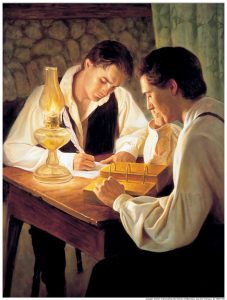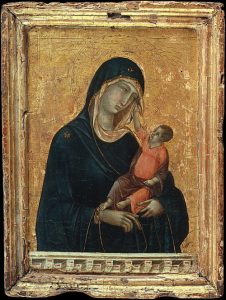Art Is Not Real Life.
I’ve had a painting depicting Nephi in my room since I was a wee lad. The reason? Nephi was a boss.
He conquered fear, doubt, and even Lamanitish armies through his faith. The painting that I have represents how I feel about Nephi; he was a mighty leader as to things temporal and spiritual. This means he was ripped six foot six inches and just over 230 pounds right?
It wasn’t until recently that I begin to consider that given his circumstances, Nephi was probably not exactly how the painting in question portrays him. Such a realization spurred on questions about other (if not all) classic church art paintings.
How was I supposed to feel? I wondered if my strong feelings toward characters such as Nephi, Joseph Smith, or even the Savior were affected by the perception I had developed over years of looking at and admiring certain works of art.
A Few Problems
Perfect accuracy is not something that Latter-day Saint artwork is known for. Let’s look at just one example.

This is one of the most commonly used paintings in the Church. It has been shown to countless investigators (and members) to give them an idea of what the translation of the Book of Mormon looked liked. The only problem is that there isn’t really anything about this painting that is historically correct.
Most accounts say Joseph Smith used seer-stones and a hat to translate the plates; he seldom if ever actually looked at them. Also, no one else was permitted to see the plates during the translation process. These two gaffs are historical inaccuracies that can pose a real challenge.
It is already shocking enough for members to hear the somewhat bizarre stories of early church history, but to add insult to injury there have been many cases where members feel a scootch deceived.
This feeling of deception may stem from growing up with certain pictures. If you have never read first-hand accounts of things like the translation of the Book of Mormon you may rely on what you see in paintings. Then you are left factually high and dry when faced with opposition connected to the painted episode.
I wonder if we have looked at painting the wrong way.
Paintings Are Not Real Life
So many things in the Church have revolved around the divine that it would be nearly impossible to paint anything with a high degree of accuracy.
Sometimes artists attempt to shed light on those things which have never entered into the heart of man. Just as mere words were not suitable to totally convey many of the visions from the scriptures, pigments are not suitable to convey all sacred scenes. So we get representations of people or events that aren’t always 100% accurate.
Should artists strive to depict things as they actually happened? Perhaps, though I wonder if the tendency to simplify and romanticize historical episodes doesn’t preserve the artist’s goal to create a scene that evokes strong feelings. “Through art, the deepest and most intangible beliefs of a culture can be translated into powerful images that communicate specific spiritual messages to the people who view them as part of their religious rituals. From the beginning of humanity, people have expressed their beliefs in material form.”
“Religious art gives visual expression to inner belief and has the ability to raise people’s spirits above the problems of daily life.”
The Most Bizzare Examples
Just for fun, take a look at three of the best worst examples of religious art gone wrong.
That’s right, soak it in.
Makes you feel bad for being so critical of current artists, doesn’t it?
 A slight inaccuracy about that one time the devil didn’t steal baby Jesus and replace him with another devil.
A slight inaccuracy about that one time the devil didn’t steal baby Jesus and replace him with another devil.
Please Don’t Be Offended
I joke about art’s tenuous relationship with reality but I know it can sometimes be more than a laughing matter. I know that it can seem disingenuous for The Church to utilize paintings that don’t adhere to the most strict narratives.
But perhaps we should give the Church, and the artists themselves, the benefit of the doubt. Why do they produce art in the first place? To provide stimulus that tends to produce strong feelings. I don’t think this is a bad thing. If you want to learn about an episode from Church history then you should read the publically available documents. If you want to appreciate artistic talent, license and have a sensory experience, look at art.




